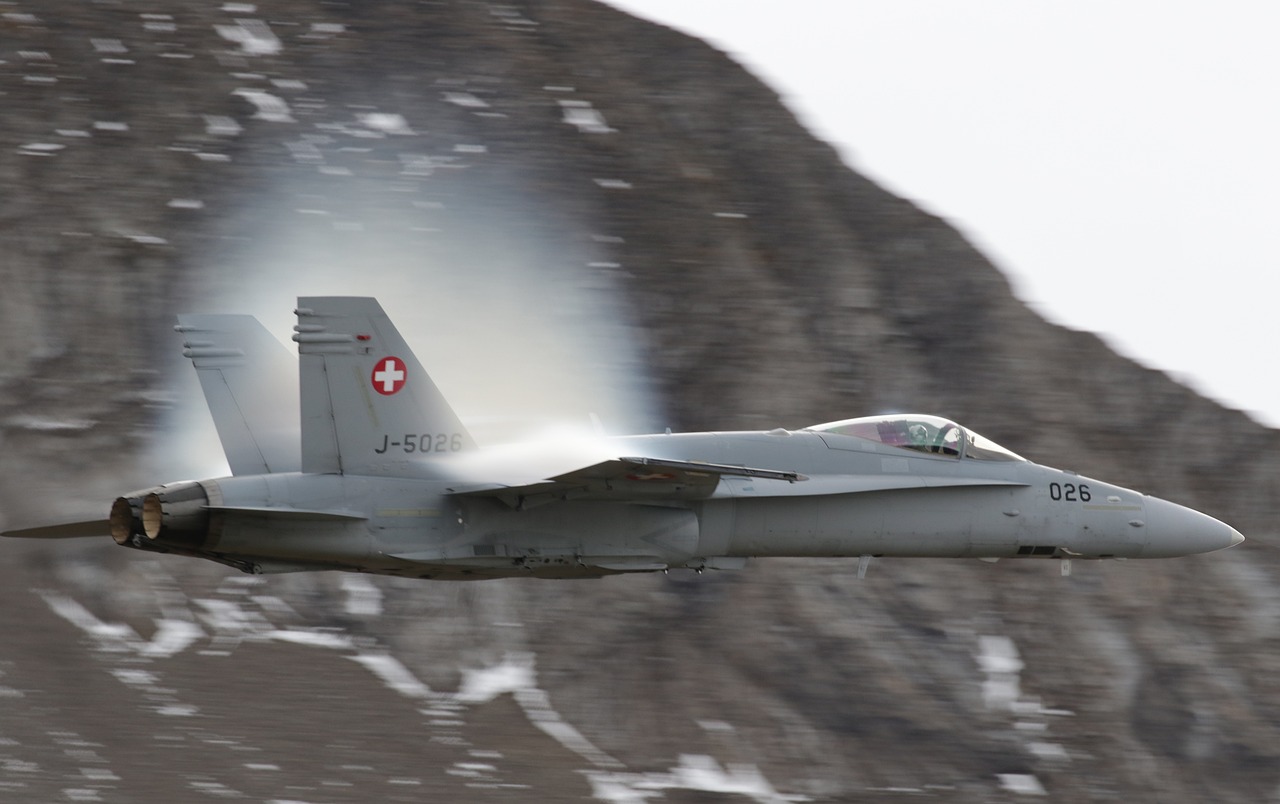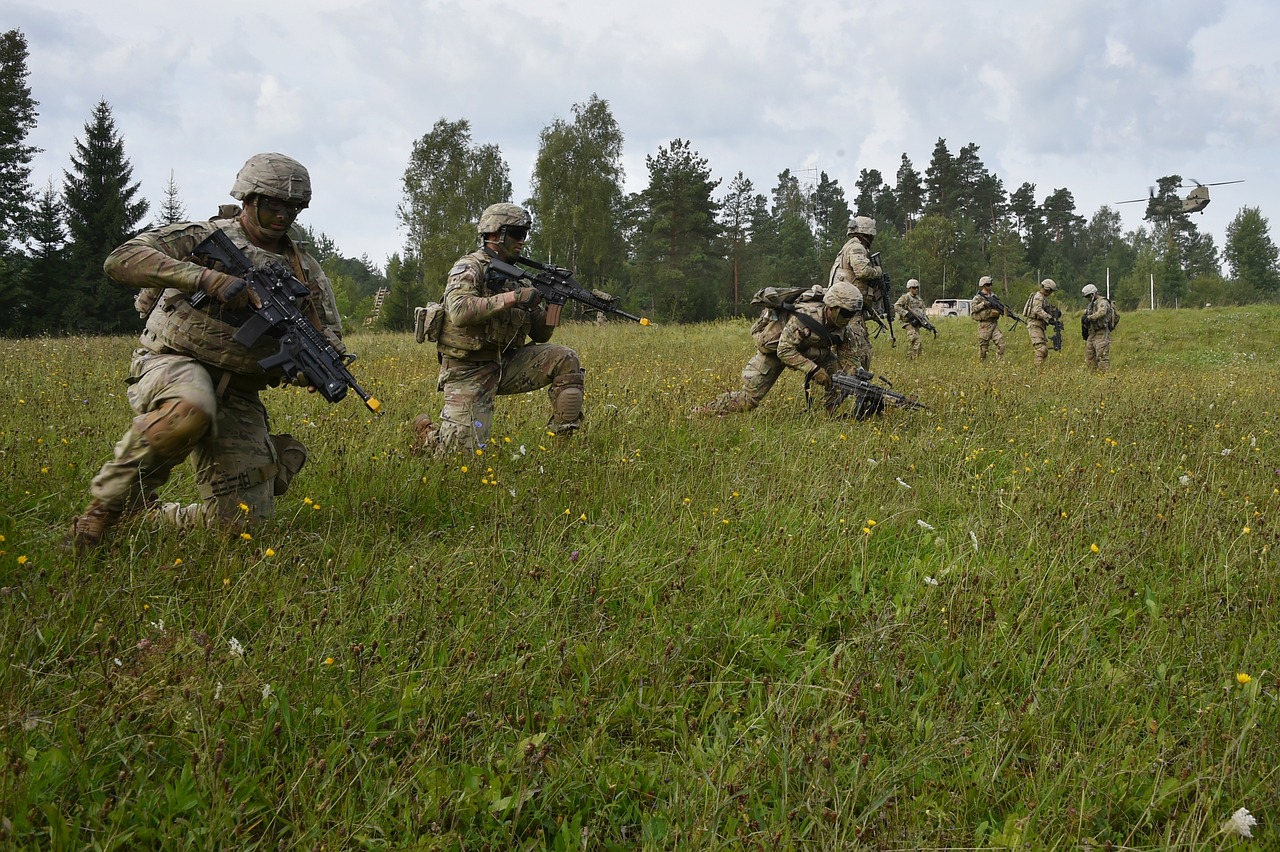The Future of Military Training - VR and Beyond
In recent years, the landscape of military training has undergone a remarkable transformation, thanks to the advent of virtual reality (VR) and other advanced technologies. These innovations are not just a passing trend; they represent a fundamental shift in how armed forces prepare for the complexities of modern warfare. Imagine a world where soldiers can engage in realistic combat scenarios without ever stepping onto a battlefield. This is the promise of VR, a tool that enhances training by immersing personnel in lifelike environments that replicate real-world challenges.
The integration of VR into military training programs is akin to upgrading from a flip phone to a smartphone. Just as smartphones revolutionized communication and access to information, VR is reshaping how soldiers acquire skills and knowledge. With VR, the traditional training methods that often relied on physical drills and simulations are being supplemented—or in some cases, replaced—by immersive experiences that offer unparalleled realism. This shift not only improves the quality of training but also prepares soldiers for the unpredictability of actual combat situations.
Moreover, the benefits of VR training extend beyond mere realism. For instance, soldiers can engage in repetitive practice in a safe and controlled environment, allowing them to hone their skills without the risks associated with live exercises. This is particularly crucial in high-stakes situations where decision-making and reflexes can mean the difference between life and death. The ability to simulate various scenarios—from urban combat to complex tactical maneuvers—ensures that soldiers are not just prepared, but battle-ready.
Another exciting aspect of VR training is its cost-effectiveness. By minimizing the need for physical resources, travel, and facility maintenance, military organizations can allocate their budgets more efficiently. For example, consider the costs associated with transporting troops to training grounds or maintaining extensive physical equipment. With VR, these costs can be drastically reduced, allowing funds to be redirected towards other critical areas, such as advanced technology development or personnel welfare.
As we delve deeper into the rise of VR in military training, it’s essential to recognize the comparative advantages it holds over traditional training methods. While traditional training often involves a one-size-fits-all approach, VR offers a level of flexibility that is simply unmatched. Soldiers can train at their own pace, repeat exercises as needed, and even engage in tailored scenarios that address specific weaknesses. This adaptability is crucial in an era where threats are constantly evolving, and preparedness must be dynamic.
Furthermore, the combination of VR with live training exercises creates a hybrid approach that maximizes the benefits of both methods. Imagine a soldier practicing in a virtual environment, then immediately applying those skills in a live exercise. This seamless integration enhances overall training effectiveness and ensures that soldiers are not only learning but also applying their knowledge in real-time situations.
However, the journey toward widespread adoption of VR in military training is not without its challenges. Initial costs can be prohibitively high, and the need for specialized equipment can complicate implementation. Additionally, thorough training on these new systems is essential to ensure that both instructors and soldiers can leverage the technology effectively. It’s a bit like learning to ride a bike—initially daunting, but once mastered, it opens up a world of possibilities.
Looking ahead, the future of military training is poised to be even more exciting with the integration of other emerging technologies. Augmented reality (AR), for instance, complements VR by overlaying digital information onto the physical world. This allows soldiers to receive real-time data and instructions during training exercises, significantly improving situational awareness. Imagine a soldier on the ground receiving live updates on enemy positions or environmental hazards—this is the power of AR.
Moreover, artificial intelligence (AI) is set to play a transformative role in personalizing training regimens. By analyzing individual performance data, AI can tailor training programs to cater to each soldier's unique strengths and weaknesses. This level of customization not only enhances combat readiness but also fosters a sense of ownership over one’s training journey.
- What is virtual reality training? Virtual reality training uses immersive technology to simulate real-world scenarios for military personnel, enhancing their learning experience.
- How does VR training improve soldier safety? VR allows soldiers to practice skills in a controlled environment without the risks associated with live exercises.
- What are the costs associated with implementing VR training? While initial costs can be high, VR training can lead to significant savings in travel and resource allocation over time.
- Can VR training be combined with traditional methods? Yes, a hybrid approach that combines VR with live exercises can enhance overall training effectiveness.

The Rise of Virtual Reality in Military Training
Virtual reality (VR) is not just a buzzword; it’s a game-changer in the realm of military training. Imagine stepping into a fully immersive environment where you can experience the chaos of battle or the precision of tactical maneuvers without ever leaving the safety of your training facility. This is the magic of VR. It allows soldiers to practice critical skills in a risk-free setting, making them better prepared for real-life scenarios. By simulating real-world situations, VR provides an unparalleled level of realism that traditional training methods simply cannot match.
The beauty of VR lies in its ability to create a controlled environment. Soldiers can engage in complex operations, experiment with various strategies, and learn from their mistakes—all without the physical and emotional toll that comes with live exercises. For instance, a soldier can repeatedly practice a high-stakes mission, adjusting their approach based on feedback, which leads to improved performance when it counts. This kind of adaptability is crucial in modern warfare, where conditions can change in the blink of an eye.
Furthermore, the immersive nature of VR training leads to higher levels of engagement among soldiers. When they are fully immersed in a scenario, they are more likely to pay attention and retain the skills they learn. This enhanced retention is vital, as military operations often require soldiers to recall their training under extreme stress. The psychological benefits of VR training can’t be overlooked; it helps build confidence, reduces anxiety, and fosters a sense of camaraderie among troops as they share experiences in these virtual landscapes.
In addition to improving engagement and retention, the scalability of VR training is another significant advantage. Training programs can be tailored to accommodate various skill levels and specialties, ensuring that every soldier receives the training they need. Whether it’s a new recruit learning the basics or an experienced operative honing advanced tactics, VR can be adjusted to meet those needs. This flexibility is particularly important in a military context, where time and resources are often limited.
As we look to the future, the integration of VR into military training programs is expected to expand. With ongoing advancements in technology, we’ll likely see even more realistic simulations that can incorporate elements like weather conditions, varying terrains, and unexpected enemy tactics. The potential for VR to evolve alongside military needs is what makes it such an exciting prospect for the armed forces.
In summary, the rise of virtual reality in military training marks a significant shift in how soldiers prepare for combat. By offering a safe, engaging, and adaptable training environment, VR not only enhances the skills of individual soldiers but also contributes to the overall effectiveness of military operations. As technology continues to advance, we can expect VR to play an even more integral role in shaping the future of military readiness.

Benefits of VR Training for Soldiers
Virtual reality (VR) training is not just a passing trend; it's a game-changer for military personnel. Imagine stepping into a world where you can practice combat scenarios without the dangers of live ammunition or the unpredictability of real-life situations. That's the beauty of VR training—it offers a safe, controlled environment where soldiers can hone their skills and build confidence. This immersive technology allows for increased engagement, making training sessions feel less like chores and more like exciting challenges.
One of the standout benefits of VR training is its ability to enhance skill retention. Traditional training methods often result in information overload, where soldiers might struggle to remember critical techniques. However, VR allows for repetitive practice in a way that feels natural and intuitive. The more soldiers engage with the VR scenarios, the better they retain the skills they learn. It's akin to playing a video game—repeated play leads to mastery. This method not only improves individual performance but also boosts team dynamics, as soldiers can practice together in a virtual space, fostering camaraderie and teamwork.
Moreover, VR training is incredibly versatile. It can be tailored to meet the specific needs of various military branches and missions. For instance, a soldier preparing for urban warfare can engage in a virtual cityscape, while another training for reconnaissance can navigate through different terrains. This customization ensures that every soldier receives training that is relevant and applicable to their roles. In this way, VR training can adapt to the ever-changing landscape of military operations, preparing soldiers for a wide array of scenarios.
Another significant advantage is the potential for cost-effectiveness. Traditional military training often requires extensive resources—think fuel for vehicles, maintenance of physical training facilities, and the logistics of travel. In contrast, VR training minimizes these costs by reducing the need for physical materials and allowing soldiers to train anywhere, anytime. A recent study showed that military units could save up to 30% on training expenses by integrating VR solutions into their programs. This not only frees up budget for other essential areas but also allows for more frequent training sessions.
It's also important to note that VR training can significantly reduce the time soldiers spend in training. With traditional methods, setting up realistic training scenarios can be time-consuming. However, with VR, scenarios can be created and modified in minutes, allowing for efficient use of training time. Soldiers can quickly transition from one scenario to another, ensuring they are exposed to a variety of situations without the logistical delays often associated with traditional training methods.
In summary, the benefits of VR training for soldiers are numerous and impactful. From enhancing engagement and retention to providing cost-effective and versatile training solutions, VR is revolutionizing how military forces prepare for the challenges ahead. As technology continues to advance, the potential for VR in military training will only grow, paving the way for a new era of preparedness and efficiency.
- What is VR training? VR training uses immersive virtual environments to simulate real-world scenarios for military personnel, allowing them to practice skills safely.
- How does VR training improve skill retention? By allowing soldiers to practice repeatedly in a realistic setting, VR helps reinforce skills and techniques, making them easier to remember.
- Is VR training cost-effective? Yes, VR training can significantly reduce costs associated with traditional training methods by minimizing the need for physical resources and travel.
- Can VR training be customized for different military roles? Absolutely! VR training can be tailored to meet the specific needs of various military branches and missions, providing relevant training experiences.

Cost-Effectiveness of VR Solutions
When we talk about military training, the phrase "cost-effectiveness" often comes up, and for good reason. Traditional training methods, while effective, can be incredibly expensive. Think about it: live-fire exercises require ammunition, maintenance of equipment, travel costs, and even the upkeep of training facilities. It's like running a marathon with a heavy backpack when you could just take a leisurely walk in a park. This is where virtual reality (VR) steps in as a game changer.
Implementing VR solutions in military training can dramatically reduce overall expenses. For instance, VR training eliminates the need for physical resources such as ammunition and vehicles, which can be a significant part of a military budget. Instead of spending thousands on live exercises, military branches can invest in a one-time purchase of VR equipment and software that can be reused indefinitely. This not only saves money but also allows for more frequent training sessions, enhancing skill retention without the financial strain.
Moreover, the flexibility of VR training means that soldiers can train in various scenarios without the logistical headaches associated with traditional methods. Imagine a scenario where soldiers need to practice urban combat. With VR, they can be placed in a fully immersive city environment without the need for a physical location. This capability reduces travel costs and the need for extensive planning, allowing military leaders to allocate resources more efficiently.
To illustrate the cost-effectiveness of VR solutions, consider the following table:
| Training Method | Initial Costs | Recurring Costs | Flexibility |
|---|---|---|---|
| Traditional Training | High | Ongoing (ammo, travel, facility maintenance) | Limited |
| Virtual Reality Training | Moderate (equipment/software) | Minimal (software updates) | High |
As seen from the table, the initial investment in VR technology is quickly offset by the reduction in ongoing costs. Additionally, the flexibility of VR allows for training in a multitude of environments and scenarios, making it a versatile option for military training. This adaptability not only prepares soldiers for various situations but also ensures that they are always combat-ready.
In conclusion, the cost-effectiveness of VR solutions in military training cannot be overstated. By reducing both initial and recurring costs while providing unparalleled flexibility, VR is paving the way for a more efficient and effective approach to preparing our armed forces for the challenges of modern warfare.
- What are the initial costs associated with VR training? Initial costs typically include the purchase of VR headsets, software licenses, and any necessary hardware upgrades.
- How does VR training compare to traditional methods? VR training offers greater flexibility, reduced costs, and the ability to simulate a wide range of scenarios without the logistical challenges of live training.
- Are there any downsides to VR training? Some challenges include the need for specialized equipment and initial setup costs, but these are often outweighed by long-term savings.
- Can VR training be integrated with live exercises? Yes, a hybrid approach combining VR with live training can enhance overall effectiveness and soldier preparedness.

Comparative Analysis: VR vs. Traditional Training
When it comes to military training, the debate between virtual reality (VR) and traditional methods is heating up. Both approaches have their merits, but the differences are striking. Traditional training often involves live exercises, which can be both resource-intensive and risky. Soldiers might find themselves in real-life scenarios, facing the unpredictability of the environment and the potential for injury. In contrast, VR training immerses soldiers in a controlled digital environment, allowing them to practice critical skills without the associated dangers.
One of the most significant advantages of VR training is the realism it offers. Imagine stepping into a virtual battlefield where you can engage with realistic scenarios, all while sitting safely in a training facility. This level of immersion can enhance the learning experience, making it easier for soldiers to retain information and apply skills in real-world situations. On the other hand, traditional training, while effective, may not provide the same depth of experience. Soldiers might be exposed to various scenarios, but the lack of immersive technology can limit their ability to fully engage with the training.
Moreover, VR training is flexible. It allows for rapid adjustments and can be tailored to meet specific training needs. Want to practice a new combat strategy? No problem! In the VR world, scenarios can be modified on the fly, accommodating the unique requirements of different units or missions. Traditional training, however, often requires extensive planning and resources to set up each exercise, making it less adaptable to sudden changes.
Cost is another critical factor in this comparison. While the initial investment in VR technology might be high, the long-term savings can be substantial. VR reduces the need for physical resources, travel, and facility maintenance, as soldiers can train in a virtual environment without the logistical challenges of traditional training. To illustrate this point, consider the following table:
| Aspect | VR Training | Traditional Training |
|---|---|---|
| Cost | High initial investment but lower long-term costs | Lower initial costs but higher ongoing expenses |
| Realism | High immersion and realism | Real-world scenarios with physical risks |
| Flexibility | Highly adaptable to various scenarios | Less adaptable; requires extensive planning |
| Engagement | High level of soldier engagement | Variable engagement; depends on the exercise |
Ultimately, the choice between VR and traditional training methods may not be a matter of one being better than the other. Instead, it could be about finding the right balance. By integrating both approaches, military training programs can leverage the strengths of each method, creating a comprehensive training experience that prepares soldiers for the complexities of modern warfare. The future of military training lies in this hybrid model, ensuring that armed forces are not only well-prepared but also adaptable to the evolving landscape of combat.
- What is virtual reality training? Virtual reality training involves using immersive technology to simulate real-world scenarios for soldiers to practice skills in a controlled environment.
- How does VR training improve soldier performance? VR training enhances engagement, retention of skills, and allows for repetitive practice without the risks associated with live exercises.
- What are the costs associated with implementing VR training? While initial costs can be high, VR training can lead to significant long-term savings by reducing the need for physical resources and travel.
- Can VR training replace traditional training methods? VR training is not meant to replace traditional methods entirely but to complement them, creating a hybrid approach that maximizes training effectiveness.

Integration with Live Training Exercises
The integration of virtual reality (VR) with live training exercises marks a significant leap forward in military training methodologies. Imagine a scenario where soldiers are not just confined to a physical training ground but can also immerse themselves in a virtual battlefield that mirrors real-world conditions. This hybrid approach allows for a more comprehensive training experience, blending the best of both worlds. By utilizing VR, military personnel can engage in realistic simulations that prepare them for various combat scenarios without the inherent risks of live-fire exercises.
One of the most compelling aspects of this integration is the ability to conduct real-time scenario training. For instance, soldiers can practice responding to a simulated ambush while simultaneously participating in a live exercise. This dual training method enhances their decision-making skills, as they learn to adapt to changing conditions in both virtual and physical environments. Moreover, the use of VR can provide critical data analytics that help assess performance during live exercises, allowing for immediate feedback and improvement.
Additionally, the combination of VR and live training can be tailored to fit specific mission objectives. For example, if a unit is preparing for a deployment in an urban environment, they can engage in VR simulations that replicate the challenges they will face. This targeted training not only increases confidence but also significantly boosts operational readiness. The ability to rehearse complex maneuvers in a controlled setting before executing them in real life can be the difference between success and failure on the battlefield.
However, to fully harness the potential of this integration, military organizations must invest in the necessary infrastructure and training for personnel. This includes not only the acquisition of VR equipment but also the development of training protocols that effectively incorporate both VR and live exercises. The goal is to create a seamless training environment where soldiers can transition effortlessly between virtual scenarios and real-world applications.
In summary, the integration of VR with live training exercises offers a transformative approach to military training. It enhances realism, fosters adaptability, and ultimately prepares soldiers for the unpredictable nature of modern warfare. As technology evolves, the potential for even more sophisticated training solutions will continue to expand, ensuring that armed forces remain at the forefront of military readiness.
- What is VR training in military contexts? VR training uses virtual reality technology to create immersive environments that simulate real-world military scenarios.
- How does VR training improve soldier performance? By providing realistic and repeatable training experiences, VR enhances skill retention and decision-making under pressure.
- Can VR training replace traditional training methods? While VR training offers many advantages, it is most effective when combined with traditional methods to create a comprehensive training program.
- What are the challenges of implementing VR in military training? Challenges include high initial costs, the need for specialized equipment, and ensuring personnel are adequately trained to use the technology.

Challenges in Implementing VR Training
While the integration of virtual reality (VR) into military training presents an exciting frontier, it is not without its challenges. One of the most pressing hurdles is the high initial costs associated with acquiring the necessary technology and equipment. This financial burden can deter military organizations from fully committing to VR solutions, especially when budgets are already stretched thin. In addition to the initial investment, there are ongoing costs related to software updates, maintenance, and potential hardware upgrades that can add to the financial strain.
Another significant challenge is the need for specialized equipment. VR training requires specific hardware such as headsets, motion sensors, and sometimes even custom-built environments. This equipment must be carefully maintained and updated, which can be a logistical nightmare for military units, particularly those deployed in remote locations. The logistics of transporting and maintaining such technology in various environments can complicate the implementation process.
Moreover, there is a necessity for thorough training on new systems. Soldiers must not only learn how to operate the VR equipment but also adapt to the new training methodologies that come with it. This transition can be daunting, especially for personnel accustomed to traditional training methods. The learning curve associated with VR technology can lead to frustration and resistance among some soldiers, making it essential for military leaders to provide adequate support and training.
Despite these challenges, the potential benefits of VR training are immense. To navigate these hurdles, military organizations can consider strategies such as:
- Establishing partnerships with tech companies to share costs and expertise.
- Implementing pilot programs to assess the effectiveness of VR training before a full rollout.
- Creating comprehensive training programs for soldiers to ease the transition to VR technology.
In summary, while the journey to fully integrate VR training into military programs is fraught with challenges, the potential for enhanced training outcomes makes it a worthy pursuit. By addressing the financial, logistical, and educational barriers, military organizations can unlock a new realm of training possibilities that prepare soldiers for the complexities of modern warfare.
Q1: What are the main benefits of using VR in military training?
A1: VR provides immersive environments that simulate real-world scenarios, allowing soldiers to practice critical skills safely and effectively. It enhances engagement, improves retention, and allows for repetitive training without the risks associated with live exercises.
Q2: Are there any safety concerns with VR training?
A2: While VR training is generally considered safe, there can be concerns related to motion sickness or discomfort from prolonged use of headsets. Proper training and acclimatization can help mitigate these issues.
Q3: How does VR training compare to traditional methods?
A3: VR training often outperforms traditional methods in terms of realism, flexibility, and adaptability. It allows for tailored training scenarios and can be conducted in a controlled environment, which is not always possible with live exercises.
Q4: What other technologies complement VR in military training?
A4: Technologies such as augmented reality (AR) and artificial intelligence (AI) are increasingly being integrated into military training. AR can provide real-time data overlays, while AI can help personalize training regimens based on individual performance.

Future Technologies in Military Training
The landscape of military training is evolving at an unprecedented pace, driven by the integration of cutting-edge technologies that promise to redefine how armed forces prepare for the complexities of modern warfare. Beyond the immersive capabilities of virtual reality (VR), a suite of innovative tools is emerging, each offering unique advantages that enhance training methodologies and outcomes. These technologies include augmented reality (AR), artificial intelligence (AI), and advanced simulation software, all of which are set to play pivotal roles in the future of military preparedness.
Augmented reality, for instance, is not merely an extension of VR; it serves as a powerful training companion that overlays digital information onto the real world. Imagine a soldier in the field, wearing AR glasses that provide real-time data about their surroundings—everything from enemy positions to equipment status—enhancing their situational awareness dramatically. This technology allows for a more interactive training experience, where soldiers can practice decision-making in dynamic environments that mimic real combat scenarios.
On the other hand, artificial intelligence is revolutionizing the personalization of training programs. By analyzing performance data, AI can identify a soldier's strengths and weaknesses, tailoring training regimens to meet individual needs. This personalized approach not only accelerates skill acquisition but also boosts overall effectiveness in combat readiness. Picture a scenario where a soldier receives instant feedback through AI-driven assessments, allowing them to focus on areas requiring improvement, thus maximizing their training efficiency.
| Technology | Benefits | Application in Military Training |
|---|---|---|
| Augmented Reality (AR) | Enhanced situational awareness, real-time data overlay | Field training exercises, tactical simulations |
| Artificial Intelligence (AI) | Personalized training regimens, performance analysis | Individual skill development, combat readiness assessments |
| Simulation Software | Realistic scenario modeling, multi-user environments | Team exercises, strategic planning |
Moreover, simulation software is becoming increasingly sophisticated, allowing for the creation of realistic battlefield scenarios that can be experienced by multiple users simultaneously. This technology enables teams to engage in complex operations, strategizing and executing plans in a controlled environment that closely resembles actual combat situations. The ability to simulate various outcomes based on different actions fosters critical thinking and teamwork, essential skills for modern soldiers.
As we look to the future, the integration of these technologies into military training programs is not just a possibility; it is an imperative. The challenges of modern warfare demand that armed forces adapt and evolve, leveraging technology to ensure that their personnel are not only prepared but excel in the face of adversity. The potential for these advancements to reshape military training is immense, and the journey has only just begun.
- What is the primary benefit of using VR in military training?
VR provides a safe and controlled environment for soldiers to practice critical skills without the risks associated with live exercises. - How does augmented reality enhance training?
AR overlays digital information onto the physical world, enabling real-time data and instructions that improve situational awareness during training exercises. - Can AI personalize training for soldiers?
Yes, AI can analyze individual performance data to create tailored training regimens that address each soldier's unique strengths and weaknesses. - What are some challenges in implementing these technologies?
Challenges include high initial costs, the need for specialized equipment, and training personnel on new systems.

Augmented Reality as a Training Tool
Augmented Reality (AR) is emerging as a game-changer in military training, offering a unique blend of the real and virtual worlds. Imagine a soldier on the battlefield, equipped with AR glasses that overlay crucial information directly onto their field of vision. This technology enhances situational awareness by providing real-time data, instructions, and even tactical maps, all while allowing the soldier to remain fully engaged in their physical environment. It’s like having a personal assistant that whispers strategic advice in your ear while you navigate the complexities of a training exercise.
One of the most exciting aspects of AR is its ability to create interactive training scenarios. For instance, soldiers can practice urban combat techniques in a simulated environment where digital enemies appear in real-time. This not only makes training more engaging but also allows for a level of realism that traditional methods simply can’t match. The combination of physical movement and digital interaction can lead to a deeper understanding of tactics and strategies, ultimately preparing soldiers for the unpredictable nature of real combat.
Moreover, AR can facilitate collaborative training exercises. Multiple soldiers can engage in the same training scenario while receiving tailored information that suits their roles. This means a medic can see a different set of data compared to a squad leader, allowing for specialized training experiences that foster teamwork and communication. As they navigate through a simulated environment, the soldiers can learn to react to each other's movements and decisions, mirroring the dynamic interactions that occur in actual missions.
However, the integration of AR into military training is not without its challenges. The technology requires a robust infrastructure and reliable equipment to function effectively. Additionally, soldiers must undergo training to familiarize themselves with AR systems, ensuring they can utilize the technology to its fullest potential. Despite these hurdles, the benefits of AR in enhancing soldier preparedness are undeniable.
In conclusion, Augmented Reality is not just a futuristic concept; it is a powerful training tool that can significantly enhance military readiness. By blending digital information with real-world scenarios, AR provides soldiers with the insights and skills they need to excel in complex environments. As the military continues to explore and implement these advanced technologies, we can expect to see a new era of training that is more effective, engaging, and adaptable than ever before.
- What is Augmented Reality (AR)? AR is a technology that overlays digital information onto the physical world, enhancing the user's perception of their environment.
- How does AR improve military training? AR enhances situational awareness by providing real-time data and instructions, allowing for more interactive and realistic training scenarios.
- What are some challenges of implementing AR in military training? Challenges include the need for specialized equipment, infrastructure, and training for soldiers to effectively use AR systems.
- Can AR be used in combination with other technologies? Yes, AR can be integrated with other technologies like Virtual Reality (VR) and Artificial Intelligence (AI) to create comprehensive training solutions.

The Role of AI in Personalized Training
Artificial Intelligence (AI) is rapidly becoming a game-changer in the realm of military training, particularly when it comes to personalization. Imagine a training program that adapts to each soldier's unique capabilities and learning pace—this is exactly what AI can achieve. By analyzing data from various training sessions, AI can identify specific strengths and weaknesses in a soldier's performance. This allows for the creation of tailored training regimens that not only enhance individual skills but also boost overall combat readiness.
One of the most compelling aspects of AI in personalized training is its ability to provide real-time feedback. During exercises, AI systems can monitor a soldier's actions and decisions, offering immediate insights that help them adjust their strategies on the fly. This instant feedback loop is akin to having a personal coach who is always present, guiding the soldier toward improvement. For instance, if a soldier struggles with a particular maneuver, the AI can suggest targeted drills that focus on that specific area, ensuring that no time is wasted on skills they have already mastered.
Furthermore, AI can track progress over time, enabling trainers to see how soldiers evolve in their capabilities. By utilizing data analytics, military leaders can make informed decisions about training methodologies and identify which techniques yield the best results. This data-driven approach not only enhances training effectiveness but also optimizes resource allocation, ensuring that every training dollar is spent wisely.
In addition to performance tracking, AI can also simulate various combat scenarios that are tailored to the individual soldier's skill level. For example, a soldier who excels in marksmanship might engage in more complex tactical drills, while another who needs improvement in decision-making can focus on strategy-based simulations. This level of customization ensures that every soldier receives the training they need to succeed on the battlefield, making them more effective and adaptable in real-world situations.
However, implementing AI-driven training solutions is not without its challenges. There are concerns about data privacy and the ethical implications of using AI in military contexts. Additionally, the integration of such advanced technology requires a significant investment in both hardware and software, as well as training for personnel on how to effectively utilize these systems. Despite these hurdles, the potential benefits of AI in personalized training are immense and cannot be overlooked.
To summarize, the role of AI in personalized training is a transformative force in military environments. By leveraging AI, military organizations can create training programs that are not only more efficient but also more effective, ultimately leading to a more prepared and capable armed force. As technology continues to evolve, the possibilities for AI in military training are boundless, and it is an exciting time to witness these advancements unfold.
- What is the primary benefit of AI in military training?
The primary benefit is the ability to create personalized training regimens that cater to individual soldiers' strengths and weaknesses, enhancing overall effectiveness. - How does AI provide feedback during training?
AI systems monitor soldiers' actions in real-time and offer immediate insights, allowing for adjustments and improvements on the spot. - What are some challenges in implementing AI in military training?
Challenges include data privacy concerns, the need for significant investment in technology, and training personnel to use these advanced systems effectively.
Frequently Asked Questions
- What is the role of virtual reality in military training?
Virtual reality (VR) serves as a game-changer in military training by creating immersive environments that mimic real-world scenarios. This allows soldiers to practice critical skills without the inherent risks of live exercises, making training both safer and more effective.
- What are the main benefits of using VR for soldiers?
The benefits of VR training for soldiers are numerous. It enhances engagement, improves retention of skills, and allows for repetitive training in a controlled environment. Essentially, it makes learning more effective and enjoyable, which is crucial for preparing soldiers for real-life situations.
- How does VR training compare to traditional training methods?
When comparing VR training to traditional methods, VR often comes out on top. It offers greater realism, flexibility, and adaptability to various training scenarios. This means soldiers can train in a way that closely resembles actual combat situations, which is invaluable for their preparedness.
- What challenges are faced in implementing VR training?
Despite its advantages, integrating VR technology into military training does come with challenges. High initial costs, the need for specialized equipment, and the necessity for thorough training on these new systems can pose significant hurdles. However, the long-term benefits often outweigh these initial challenges.
- What other technologies are being integrated into military training?
Beyond VR, emerging technologies like augmented reality (AR), artificial intelligence (AI), and advanced simulation software are set to further enhance military training methodologies. These technologies can provide real-time data, personalized training experiences, and even improve situational awareness during exercises.
- How does augmented reality enhance military training?
Augmented reality complements VR by overlaying digital information onto the physical environment. This allows soldiers to receive real-time data and instructions during training, significantly improving their situational awareness and decision-making skills.
- What is the role of AI in military training?
Artificial intelligence plays a crucial role in personalizing training regimens. By analyzing individual performance data, AI can tailor training programs to match each soldier's strengths and weaknesses, ultimately leading to improved combat readiness and effectiveness.



















